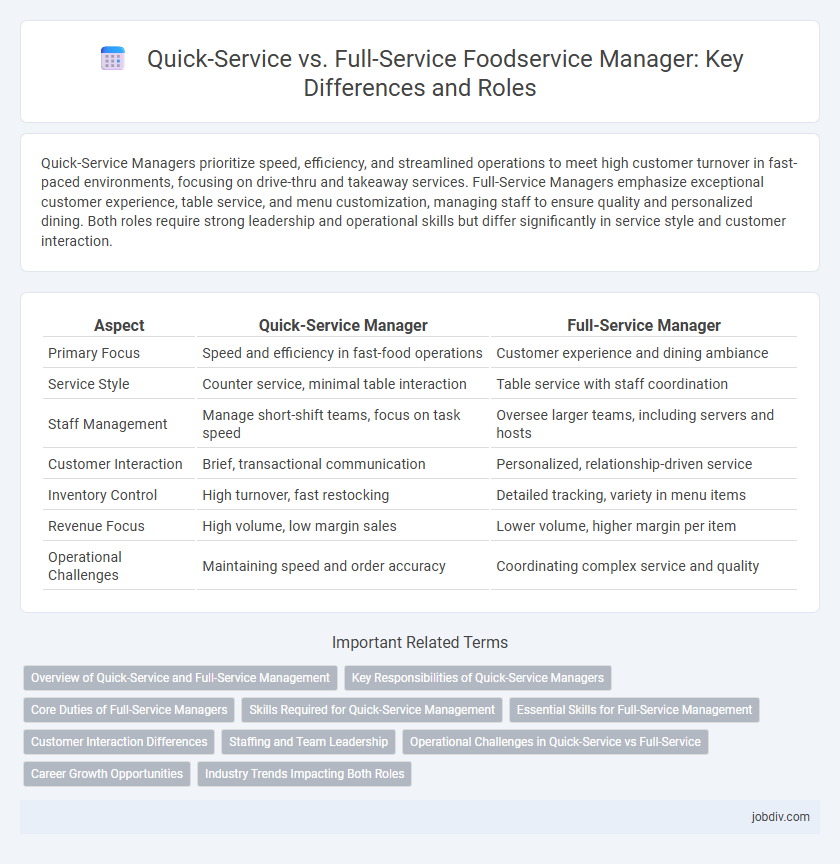Quick-Service Managers prioritize speed, efficiency, and streamlined operations to meet high customer turnover in fast-paced environments, focusing on drive-thru and takeaway services. Full-Service Managers emphasize exceptional customer experience, table service, and menu customization, managing staff to ensure quality and personalized dining. Both roles require strong leadership and operational skills but differ significantly in service style and customer interaction.
Table of Comparison
| Aspect | Quick-Service Manager | Full-Service Manager |
|---|---|---|
| Primary Focus | Speed and efficiency in fast-food operations | Customer experience and dining ambiance |
| Service Style | Counter service, minimal table interaction | Table service with staff coordination |
| Staff Management | Manage short-shift teams, focus on task speed | Oversee larger teams, including servers and hosts |
| Customer Interaction | Brief, transactional communication | Personalized, relationship-driven service |
| Inventory Control | High turnover, fast restocking | Detailed tracking, variety in menu items |
| Revenue Focus | High volume, low margin sales | Lower volume, higher margin per item |
| Operational Challenges | Maintaining speed and order accuracy | Coordinating complex service and quality |
Overview of Quick-Service and Full-Service Management
Quick-Service Managers oversee fast-paced operations emphasizing speed, efficiency, and standardized menu offerings, ensuring quick customer turnaround and streamlined food preparation processes. Full-Service Managers handle more complex dining environments focused on personalized customer service, extensive menu options, and higher staff coordination to enhance the overall guest experience. Both roles require strong leadership but differ significantly in operational priorities and customer interaction strategies within the foodservice industry.
Key Responsibilities of Quick-Service Managers
Quick-service managers focus on overseeing fast-paced restaurant operations, ensuring efficient order processing, maintaining food quality, and managing staff schedules. They prioritize customer satisfaction through speed and accuracy, adherence to health and safety standards, and inventory control to minimize waste. Unlike full-service managers, their responsibilities emphasize rapid service flow, drive-thru management, and optimizing throughput to maximize daily sales.
Core Duties of Full-Service Managers
Full-Service Managers oversee comprehensive restaurant operations including staff management, customer experience, and quality control in dining establishments. They coordinate front-of-house and back-of-house activities to ensure efficient service, maintain health and safety standards, and manage inventory and budgeting. Their core duties emphasize personalized guest interaction, handling reservations, and supervising a diverse team to deliver high-quality dining experiences.
Skills Required for Quick-Service Management
Quick-Service Managers require strong multitasking abilities, rapid decision-making skills, and expertise in efficient operational execution to maintain high service speeds and consistency. Proficiency in staff training, inventory control, and customer service optimization is essential to handle fast-paced environments and high customer turnover. Mastery of technology-driven tools for order processing and performance tracking further enhances operational efficiency in quick-service restaurants.
Essential Skills for Full-Service Management
Mastering customer service excellence, conflict resolution, and team leadership are essential skills for Full-Service Managers, ensuring a high-quality dining experience. Proficiency in inventory management, staff scheduling, and compliance with health and safety regulations drives operational efficiency in full-service restaurants. Strong communication skills and emotional intelligence enable Full-Service Managers to handle dynamic environments and diverse guest needs effectively.
Customer Interaction Differences
Quick-Service Managers prioritize efficient customer interactions by streamlining order-taking and minimizing wait times to enhance throughput and satisfaction. Full-Service Managers emphasize personalized service, often engaging with customers throughout their dining experience to address specific needs and create a welcoming atmosphere. The varying roles reflect distinct strategies to optimize customer loyalty and operational flow within quick-service and full-service restaurant environments.
Staffing and Team Leadership
Quick-Service Managers prioritize efficient staffing with a focus on rapid employee turnover to maintain fast-paced operations, often managing larger teams with clearly defined, task-oriented roles. Full-Service Managers emphasize developing strong team leadership skills to enhance staff performance and customer interaction, working closely with smaller teams to ensure personalized service. Staffing strategies for quick-service lean on scheduling flexibility and cross-training, while full-service relies on cultivating employee expertise and morale.
Operational Challenges in Quick-Service vs Full-Service
Quick-service managers face operational challenges such as high customer turnover, rapid order fulfillment, and maintaining consistency during peak hours. Full-service managers handle complex table service coordination, personalized customer interactions, and managing extended meal durations. Both roles require efficient staffing, inventory control, and quality assurance but differ significantly in pace and customer experience demands.
Career Growth Opportunities
Quick-Service Managers often experience faster career growth due to high turnover rates and scalable operational roles in fast-paced environments, leading to opportunities in regional management or franchise ownership. Full-Service Managers gain deeper expertise in customer service, fine dining operations, and staff training, which can progress into positions like food and beverage directors or hospitality consultants. Both career paths offer distinct growth trajectories aligned with different skill sets and industry demands in the foodservice sector.
Industry Trends Impacting Both Roles
Emerging technology integration in ordering and payment systems is reshaping responsibilities for both Quick-Service and Full-Service Managers, requiring adaptability to digital tools and customer expectations. Increased emphasis on sustainability and local sourcing is driving operational adjustments, influencing supply chain management and menu planning across both service models. Labor shortages and evolving workforce dynamics necessitate enhanced leadership strategies, focusing on staff retention and training in high-turnover environments.
Quick-Service Manager vs Full-Service Manager Infographic

 jobdiv.com
jobdiv.com